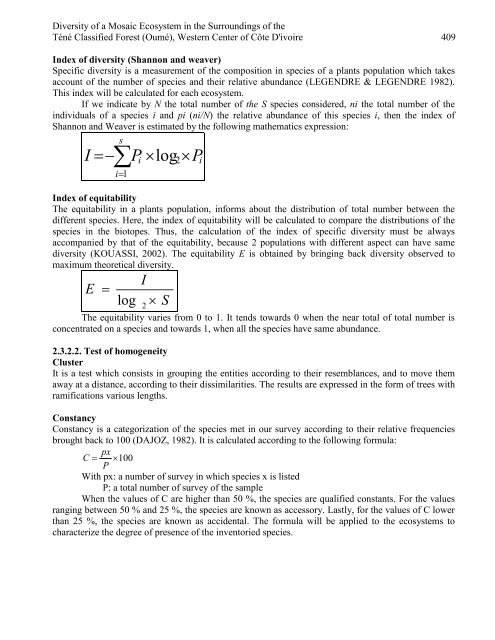European Journal of Scientific Research - EuroJournals
European Journal of Scientific Research - EuroJournals
European Journal of Scientific Research - EuroJournals
Create successful ePaper yourself
Turn your PDF publications into a flip-book with our unique Google optimized e-Paper software.
Diversity <strong>of</strong> a Mosaic Ecosystem in the Surroundings <strong>of</strong> the<br />
Téné Classified Forest (Oumé), Western Center <strong>of</strong> Côte D'ivoire 409<br />
Index <strong>of</strong> diversity (Shannon and weaver)<br />
Specific diversity is a measurement <strong>of</strong> the composition in species <strong>of</strong> a plants population which takes<br />
account <strong>of</strong> the number <strong>of</strong> species and their relative abundance (LEGENDRE & LEGENDRE 1982).<br />
This index will be calculated for each ecosystem.<br />
If we indicate by N the total number <strong>of</strong> the S species considered, ni the total number <strong>of</strong> the<br />
individuals <strong>of</strong> a species i and pi (ni/N) the relative abundance <strong>of</strong> this species i, then the index <strong>of</strong><br />
Shannon and Weaver is estimated by the following mathematics expression:<br />
s<br />
I = −∑<br />
Pi<br />
× log2×<br />
Pi<br />
i=<br />
1<br />
Index <strong>of</strong> equitability<br />
The equitability in a plants population, informs about the distribution <strong>of</strong> total number between the<br />
different species. Here, the index <strong>of</strong> equitability will be calculated to compare the distributions <strong>of</strong> the<br />
species in the biotopes. Thus, the calculation <strong>of</strong> the index <strong>of</strong> specific diversity must be always<br />
accompanied by that <strong>of</strong> the equitability, because 2 populations with different aspect can have same<br />
diversity (KOUASSI, 2002). The equitability E is obtained by bringing back diversity observed to<br />
maximum theoretical diversity.<br />
E<br />
=<br />
log<br />
I<br />
×<br />
S<br />
2<br />
The equitability varies from 0 to 1. It tends towards 0 when the near total <strong>of</strong> total number is<br />
concentrated on a species and towards 1, when all the species have same abundance.<br />
2.3.2.2. Test <strong>of</strong> homogeneity<br />
Cluster<br />
It is a test which consists in grouping the entities according to their resemblances, and to move them<br />
away at a distance, according to their dissimilarities. The results are expressed in the form <strong>of</strong> trees with<br />
ramifications various lengths.<br />
Constancy<br />
Constancy is a categorization <strong>of</strong> the species met in our survey according to their relative frequencies<br />
brought back to 100 (DAJOZ, 1982). It is calculated according to the following formula:<br />
px<br />
C = × 100<br />
P<br />
With px: a number <strong>of</strong> survey in which species x is listed<br />
P: a total number <strong>of</strong> survey <strong>of</strong> the sample<br />
When the values <strong>of</strong> C are higher than 50 %, the species are qualified constants. For the values<br />
ranging between 50 % and 25 %, the species are known as accessory. Lastly, for the values <strong>of</strong> C lower<br />
than 25 %, the species are known as accidental. The formula will be applied to the ecosystems to<br />
characterize the degree <strong>of</strong> presence <strong>of</strong> the inventoried species.

















